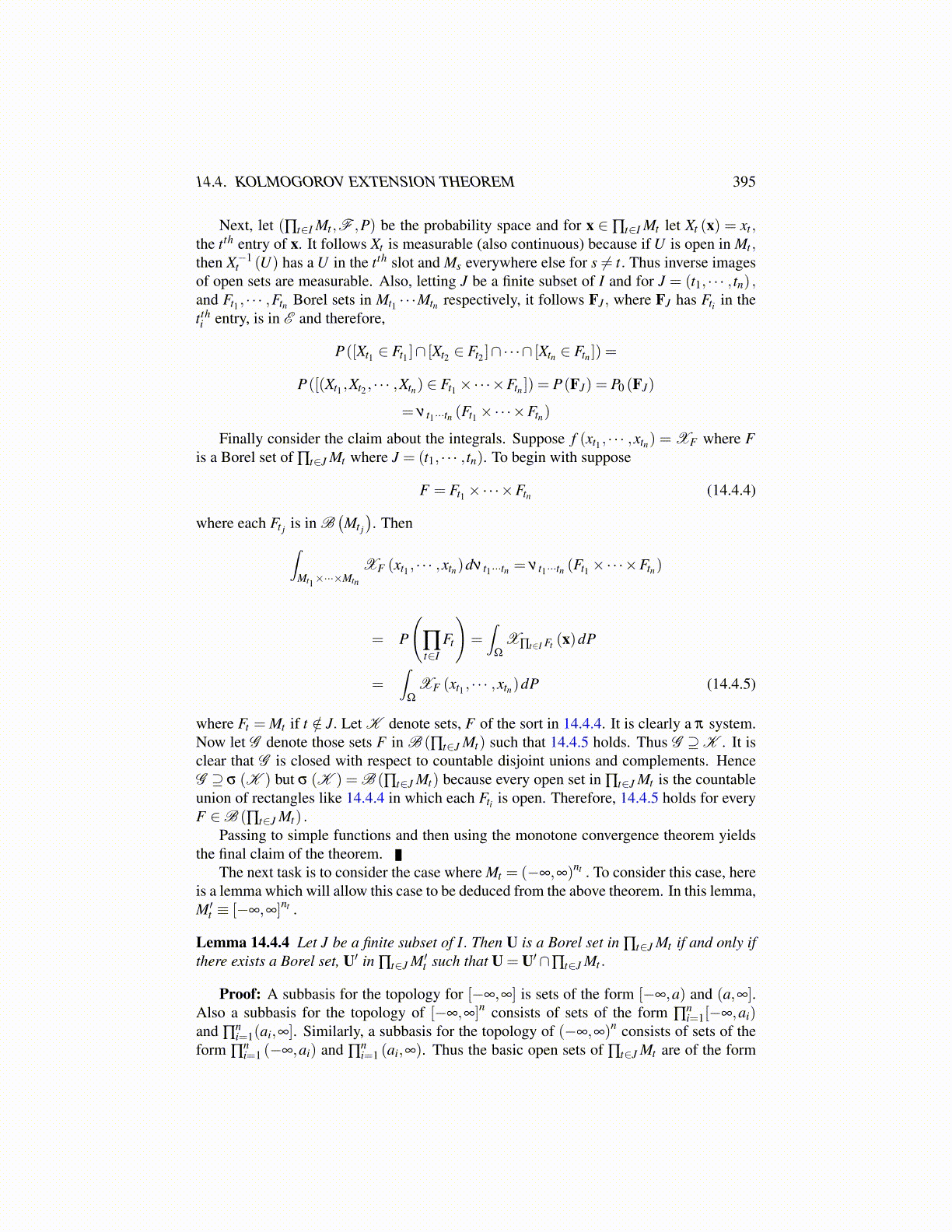
14.4. KOLMOGOROV EXTENSION THEOREM 395
Next, let (∏t∈I Mt ,F ,P) be the probability space and for x ∈ ∏t∈I Mt let Xt (x) = xt ,the tth entry of x. It follows Xt is measurable (also continuous) because if U is open in Mt ,then X−1
t (U) has a U in the tth slot and Ms everywhere else for s ̸= t. Thus inverse imagesof open sets are measurable. Also, letting J be a finite subset of I and for J = (t1, · · · , tn) ,and Ft1 , · · · ,Ftn Borel sets in Mt1 · · ·Mtn respectively, it follows FJ , where FJ has Fti in thetthi entry, is in E and therefore,
P([Xt1 ∈ Ft1 ]∩ [Xt2 ∈ Ft2 ]∩·· ·∩ [Xtn ∈ Ftn ]) =
P([(Xt1 ,Xt2 , · · · ,Xtn) ∈ Ft1 ×·· ·×Ftn ]) = P(FJ) = P0 (FJ)
= ν t1···tn (Ft1 ×·· ·×Ftn)
Finally consider the claim about the integrals. Suppose f (xt1 , · · · ,xtn) = XF where Fis a Borel set of ∏t∈J Mt where J = (t1, · · · , tn). To begin with suppose
F = Ft1 ×·· ·×Ftn (14.4.4)
where each Ft j is in B(Mt j
). Then∫
Mt1×···×Mtn
XF (xt1 , · · · ,xtn)dν t1···tn = ν t1···tn (Ft1 ×·· ·×Ftn)
= P
(∏t∈I
Ft
)=∫
Ω
X∏t∈I Ft (x)dP
=∫
Ω
XF (xt1 , · · · ,xtn)dP (14.4.5)
where Ft = Mt if t /∈ J. Let K denote sets, F of the sort in 14.4.4. It is clearly a π system.Now let G denote those sets F in B (∏t∈J Mt) such that 14.4.5 holds. Thus G ⊇K . It isclear that G is closed with respect to countable disjoint unions and complements. HenceG ⊇ σ (K ) but σ (K ) = B (∏t∈J Mt) because every open set in ∏t∈J Mt is the countableunion of rectangles like 14.4.4 in which each Fti is open. Therefore, 14.4.5 holds for everyF ∈B (∏t∈J Mt) .
Passing to simple functions and then using the monotone convergence theorem yieldsthe final claim of the theorem.
The next task is to consider the case where Mt = (−∞,∞)nt . To consider this case, hereis a lemma which will allow this case to be deduced from the above theorem. In this lemma,M′t ≡ [−∞,∞]nt .
Lemma 14.4.4 Let J be a finite subset of I. Then U is a Borel set in ∏t∈J Mt if and only ifthere exists a Borel set, U′ in ∏t∈J M′t such that U = U′∩∏t∈J Mt .
Proof: A subbasis for the topology for [−∞,∞] is sets of the form [−∞,a) and (a,∞].Also a subbasis for the topology of [−∞,∞]n consists of sets of the form ∏
ni=1[−∞,ai)
and ∏ni=1(ai,∞]. Similarly, a subbasis for the topology of (−∞,∞)n consists of sets of the
form ∏ni=1 (−∞,ai) and ∏
ni=1 (ai,∞). Thus the basic open sets of ∏t∈J Mt are of the form